key Peugeot Bipper 2015 Owner's Guide
[x] Cancel search | Manufacturer: PEUGEOT, Model Year: 2015, Model line: Bipper, Model: Peugeot Bipper 2015Pages: 192, PDF Size: 7.97 MB
Page 63 of 192
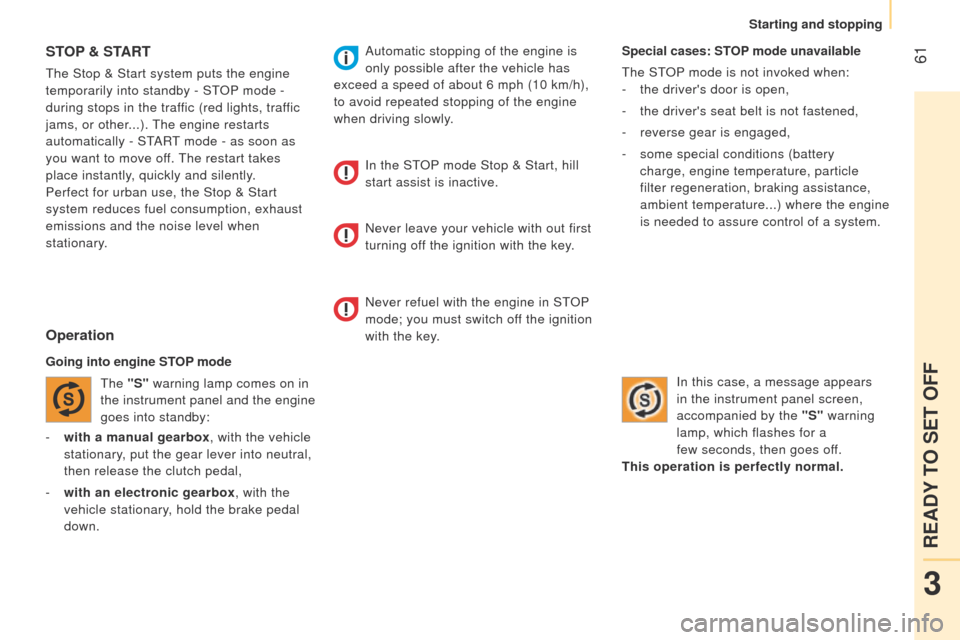
61
Bipper_en_Chap03_pret-a-partir_ed02-2014
- with a manual gearbox, with the vehicle
stationary, put the gear lever into neutral,
then release the clutch pedal,
-
with an electronic gearbox
, with the
vehicle stationary, hold the brake pedal
down. Special cases: STOP mode unavailable
t
he S t
OP
mode is not invoked when:
-
the driver's door is open,
-
the driver's seat belt is not fastened,
-
reverse gear is engaged,
-
some special conditions (battery
charge, engine temperature, particle
filter regeneration, braking assistance,
ambient temperature...) where the engine
is needed to assure control of a system.
In this case, a message appears
in the instrument panel screen,
accompanied by the "S" warning
lamp, which flashes for a
few seconds, then goes off.
This operation is perfectly normal.
STOP & S TART
the Stop & Start system puts the engine
temporarily into standby - S t
OP
mode -
during stops in the traffic (red lights, traffic
jams, or other...).
t
he engine restarts
automatically - S
t
ARt mode - as soon as
you want to move off.
t
he restart takes
place instantly, quickly and silently.
Perfect for urban use, the Stop & Start
system reduces fuel consumption, exhaust
emissions and the noise level when
stationary.
Operation
Going into engine STOP mode
t
he "S" warning lamp comes on in
the instrument panel and the engine
goes into standby: Automatic stopping of the engine is
only possible after the vehicle has
exceed a speed of about 6 mph (10 km/h),
to avoid repeated stopping of the engine
when driving slowly.
In the S t
OP
mode Stop & Start, hill
start assist is inactive.
Never leave your vehicle with out first
turning off the ignition with the key.
Never refuel with the engine in S
t
OP
mode; you must switch off the ignition
with the key.
3
READY TO SET OFF
Starting and stopping
Page 64 of 192
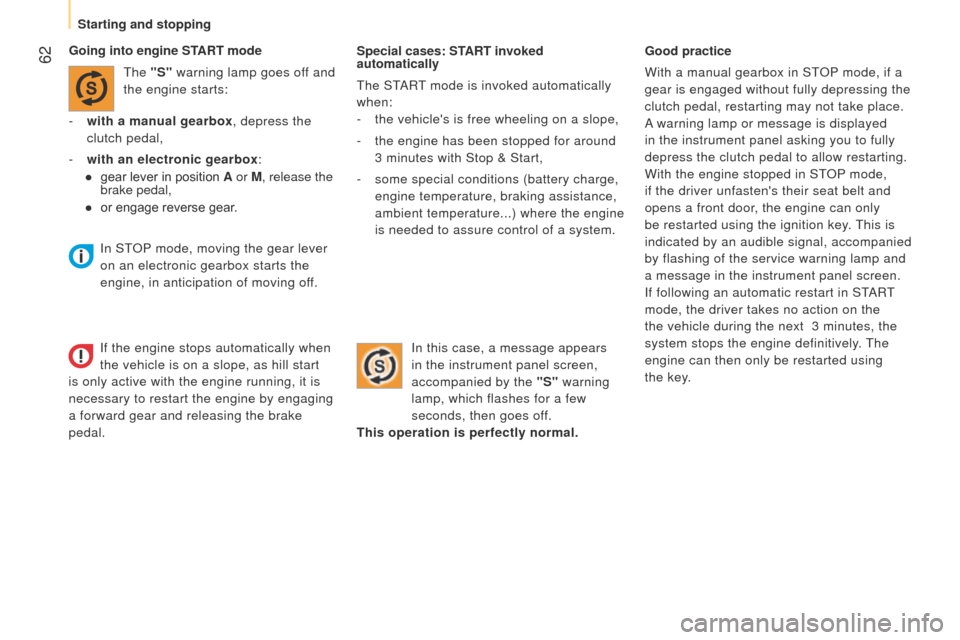
62
Bipper_en_Chap03_pret-a-partir_ed02-2014
Special cases: START invoked
automatically
t
he S t
ARt mode is invoked automatically
when:
-
the vehicle's is free wheeling on a slope,
-
the engine has been stopped for around
3 minutes with Stop & Start,
-
some special conditions (battery charge,
engine temperature, braking assistance,
ambient temperature...) where the engine
is needed to assure control of a system. Good practice
With a manual gearbox in S
t
OP
mode, if a
gear is engaged without fully depressing the
clutch pedal, restarting may not take place.
A warning lamp or message is displayed
in the instrument panel asking you to fully
depress the clutch pedal to allow restarting.
With the engine stopped in S
t
OP
mode,
if the driver unfasten's their seat belt and
opens a front door, the engine can only
be restarted using the ignition key.
t
his is
indicated by an audible signal, accompanied
by flashing of the service warning lamp and
a message in the instrument panel screen.
If following an automatic restart in S
t
ARt
mode, the driver takes no action on the
the vehicle during the next
3 minutes, the
system stops the engine definitively.
t
he
engine can then only be restarted using
the key.
Going into engine START mode
t
he "S" warning lamp goes off and
the engine starts:
-
with a manual gearbox
, depress the
clutch pedal,
-
with an electronic gearbox
:
●
gear lever in position
A or M, release the
brake pedal,
●
or engage rever
se gear. In this case, a message appears
in the instrument panel screen,
accompanied by the "S" warning
lamp, which flashes for a few
seconds, then goes off.
This operation is perfectly normal.
In S
t
OP
mode, moving the gear lever
on an electronic gearbox starts the
engine, in anticipation of moving off.
If the engine stops automatically when
the vehicle is on a slope, as hill start
is only active with the engine running, it is
necessary to restart the engine by engaging
a forward gear and releasing the brake
pedal.
Starting and stopping
Page 65 of 192
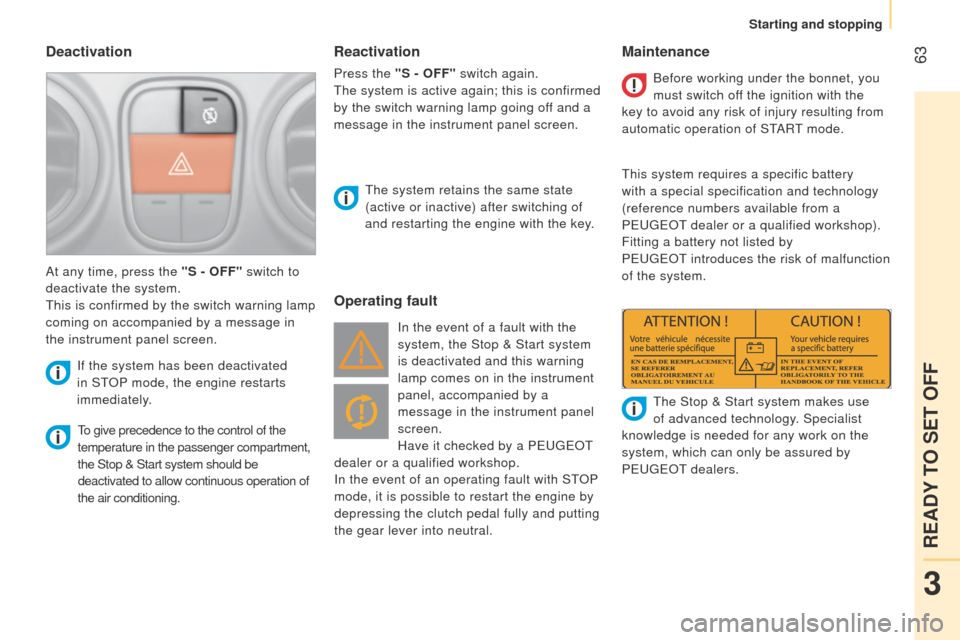
63
Bipper_en_Chap03_pret-a-partir_ed02-2014
Deactivation
to give precedence to the control of the
temperature in the passenger compartment,
the Stop & Start system should be
deactivated to allow continuous operation of
the air conditioning.
t
he system retains the same state
(active or inactive) after switching of
and restarting the engine with the key.
At any time, press the "S - OFF" switch to
deactivate the system.
t
his is confirmed by the switch warning lamp
coming on accompanied by a message in
the instrument panel screen.
If the system has been deactivated
in St
OP
mode, the engine restarts
immediately.
Operating fault Maintenance
In the event of a fault with the
system, the Stop & Start system
is deactivated and this warning
lamp comes on in the instrument
panel, accompanied by a
message in the instrument panel
screen.
Have it checked by a P
euge O t
dealer or a qualified workshop.
In the event of an operating fault with S
t
OP
mode, it is possible to restart the engine by
depressing the clutch pedal fully and putting
the gear lever into neutral. Before working under the bonnet, you
must switch off the ignition with the
key to avoid any risk of injury resulting from
automatic operation of S t
ARt mode.
t
his system requires a specific battery
with a special specification and technology
(reference numbers available from a
P euge O t
dealer or a qualified workshop).
Fitting a battery not listed by
P euge O t introduces the risk of malfunction
of the system.
t
he Stop & Start system makes use
of advanced technology. Specialist
knowledge is needed for any work on the
system, which can only be assured by
P
euge O t
dealers.
Reactivation
Press the "S - OFF" switch again.
t
he system is active again; this is confirmed
by the switch warning lamp going off and a
message in the instrument panel screen.
3
READY TO SET OFF
Starting and stopping
Page 93 of 192
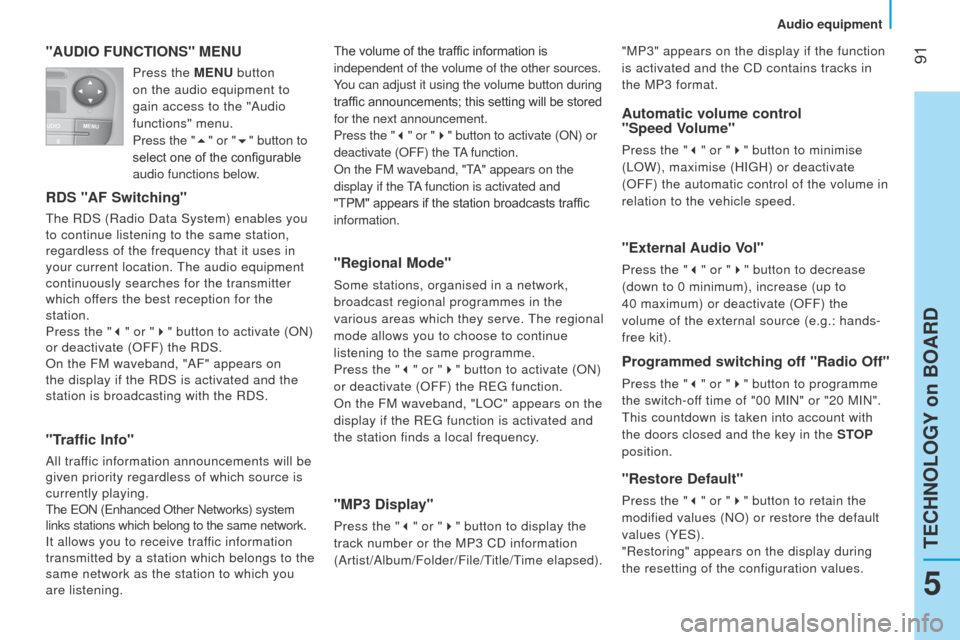
91
Bipper_en_Chap05_technologie_ed02-2014
"AUDIO FUNCTIONS" MENU
RDS "AF Switching"
the RDS (Radio Data System) enables you
to continue listening to the same station,
regardless of the frequency that it uses in
your current location.
t
he audio equipment
continuously searches for the transmitter
which offers the best reception for the
station.
Press the " 3" or " 4" button to activate (ON)
or deactivate (OFF) the RDS.
On the FM waveband, "AF" appears on
the display if the RDS is activated and the
station is broadcasting with the RDS.
"Traffic Info"
All traffic information announcements will be
given priority regardless of which source is
currently playing.
t
he e ON ( e nhanced Other Networks) system
links stations which belong to the same network.
It allows you to receive traffic information
transmitted by a station which belongs to the
same network as the station to which you
are listening.
"Regional Mode"
Some stations, organised in a network,
broadcast regional programmes in the
various areas which they serve.
t
he regional
mode allows you to choose to continue
listening to the same programme.
Press the " 3" or " 4" button to activate (ON)
or deactivate (OFF) the R
eg function.
On the FM waveband, "
l OC" appears on the
display if the R
eg function is activated and
the station finds a local frequency.
"MP3 Display"
Press the " 3" or " 4" button to display the
track number or the MP3 CD information
(Artist/Album/Folder/File/
t
itle/
t
ime elapsed).
Automatic volume control
"Speed Volume"
Press the " 3" or " 4" button to minimise
( l OW), maximise (HI g H) or deactivate
(OFF) the automatic control of the volume in
relation to the vehicle speed.
The volume of the traffic information is
independent of the volume of the other sources.
You can adjust it using the volume button during
traffic announcements; this setting will be stored
for the next announcement.
Press the "
3" or " 4" button to activate (ON) or
deactivate (OFF) the tA
function.
On the FM waveband, "
t
A" appears on the
display if the
tA
function is activated and
"TPM" appears if the station broadcasts traffic
information.
"External Audio Vol"
Press the " 3" or " 4" button to decrease
(down to 0 minimum), increase (up to
40
maximum) or deactivate (OFF) the
volume of the external source (e.g.: hands-
free kit).
Programmed switching off "Radio Off"
Press the " 3" or " 4" button to programme
the switch-off time of "00 MIN" or "20 MIN".
t
his countdown is taken into account with
the doors closed and the key in the STOP
position.
"Restore Default"
Press the " 3" or " 4" button to retain the
modified values (NO) or restore the default
values (Y
e S).
"Restoring" appears on the display during
the resetting of the configuration values. "MP3" appears on the display if the function
is activated and the CD contains tracks in
the MP3 format.
Press the MENU
button
on the audio equipment to
gain access to the "Audio
functions" menu.
Press the "5" or "6" button to
select one of the configurable
audio functions below.
5
TECHNOLOGY on BOARD
Audio equipment
Page 102 of 192
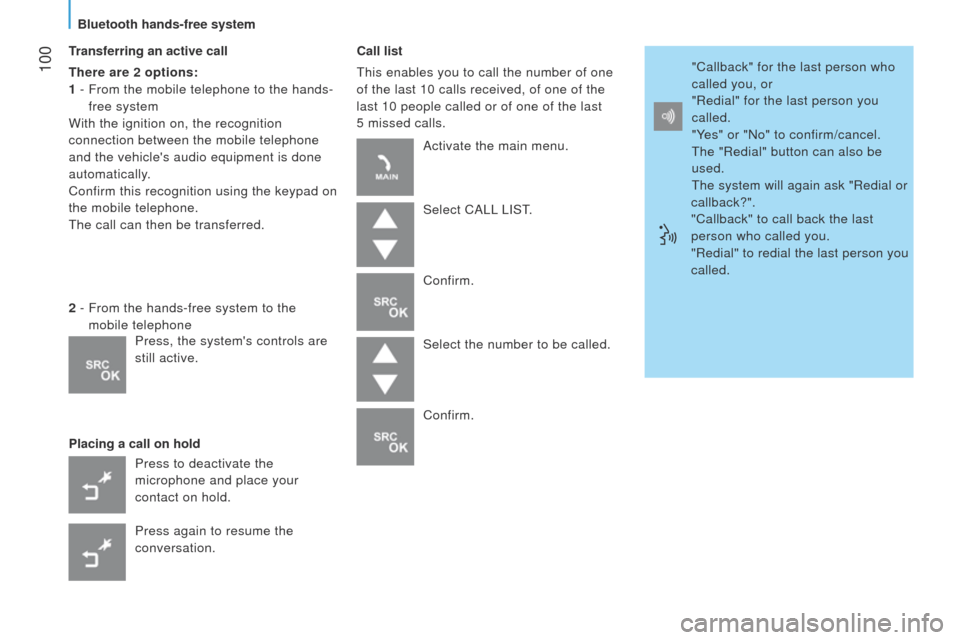
100
Bipper_en_Chap05_technologie_ed02-2014
Transferring an active call
There are 2 options:
1 -
From the mobile telephone to the hands-
free system
With the ignition on, the recognition
connection between the mobile telephone
and the vehicle's audio equipment is done
automatically.
Confirm this recognition using the keypad on
the mobile telephone.
t
he call can then be transferred.
Placing a call on hold Call list
t
his enables you to call the number of one
of the last 10 calls received, of one of the
last 10 people called or of one of the last
5
missed calls.
2 -
From the hands-free system to the
mobile telephone
Press to deactivate the
microphone and place your
contact on hold.
Press again to resume the
conversation. Activate the main menu.
Select CA
ll
l IS t
.
Confirm.
Select the number to be called.
Confirm. "Callback" for the last person who
called you, or
"Redial" for the last person you
called.
"Yes" or "No" to confirm/cancel.
t
he "Redial" button can also be
used.
t
he system will again ask "Redial or
callback?".
"Callback" to call back the last
person who called you.
"Redial" to redial the last person you
called.
Press, the system's controls are
still active.
Bluetooth hands-free system
Page 103 of 192

101
Bipper_en_Chap05_technologie_ed02-2014
VOICE COMMANDS
the key words which can be recognised by the system are organised into th\
ree levels (levels 1, 2 and 3).
When you say a level 1 command, the system makes the level 2 commands av\
ailable; when you say a level 2 command, the
system makes the level 3 commands available.
Settings/pairing
Level 1 Level 2Level 3 Actions
Settings
Adjust
Configure
u
ser data Activation of the hands-free system S
ett IN g S menu.
Activation of the
u S e R DA
tA
menu.
Delete users Deletion of the data recorded for all of the users.
Delete contacts/
Delete directory/
Delete numbers Deletion of the phone book data.
Copy phone book/
Copy phonebook/
Copy numbers
transfer of the phone books from your mobile telephone to the
hands-free system (available according to the type of mobile
telephone).
Add Contacts
transfer of the names from your mobile telephone to the hands-free
system (available according to the type of mobile).
Delete all Deletion of the pairing data and of the phone books/contacts of all
of the telephones paired, with restoration of the default settings of
the hands-free system.
Pairing/Pair/Pair the user Activation of the pairing procedure for a new mobile telephone.
Advanced options Activation of the ADVANC
e D OP t IONS menu.
teCHNOlOgY on BOARD
Bluetooth hands-free system
5
Page 104 of 192
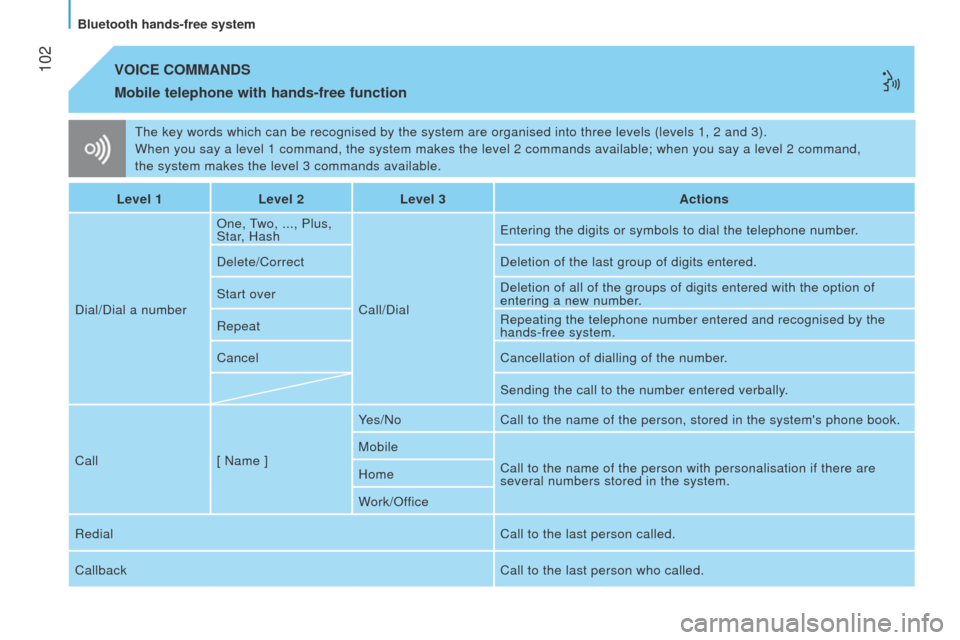
102
Bipper_en_Chap05_technologie_ed02-2014
the key words which can be recognised by the system are organised into th\
ree levels (levels 1, 2 and 3).
When you say a level 1 command, the system makes the level 2 commands av\
ailable; when you say a level 2 command,
the
system makes the level 3 commands available.
VOICE COMMANDS
Mobile
telephone with hands-free function
Level 1 Level 2Level 3 Actions
Dial/Dial a number One,
two, ..., Plus,
Star, Hash
Call/Dial
e
ntering the digits or symbols to dial the telephone number.
Delete/Correct Deletion of the last group of digits entered.
Start over Deletion of all of the groups of digits entered with the option of
entering a new number.
Repeat Repeating the telephone number entered and recognised by the
hands-free system.
Cancel Cancellation of dialling of the number.
Sending the call to the number entered verbally.
Call [ Name ]Yes/No
Call to the name of the person, stored in the system's phone book.
Mobile Call to the name of the person with personalisation if there are
several numbers stored in the system.
Home
Work/Office
Redial Call to the last person called.
Callback Call to the last person who called.
Bluetooth hands-free system
Page 107 of 192

105
Bipper_en_Chap05_technologie_ed02-2014
VOICE COMMANDS
Message reader
the key words which can be recognised by the system are organised into th\
ree levels (levels 1, 2 and 3).
When you say a level 1 command, the system makes the level 2 commands av\
ailable; when you say a level 2 command,
the
system makes the level 3 commands available.
Level 1 Level 2Level 3 Actions
Message reader
Messages Messages received /
Received Activation of the M
e SS. R e AD e R menu.
Activation of the list of text messages received.
Read/ read again Reads the text message selected in the list.
CA
ll
Deletion of the phone book data.
Delete
transfer of the phone books from your mobile telephone to the
hands-free system (available according to the type of mobile).
Back / Next / N
e X tg
o to the next text message in the list
Back / PR
e VIO u S
g
o to the previous test message in the list.
Read last / read last message / read message Read the last text message received.
Delete all / Delete messages / Delete Delete all text messages in the list after confirmation.
teCHNOlOgY on BOARD
Bluetooth hands-free system
5
Page 111 of 192
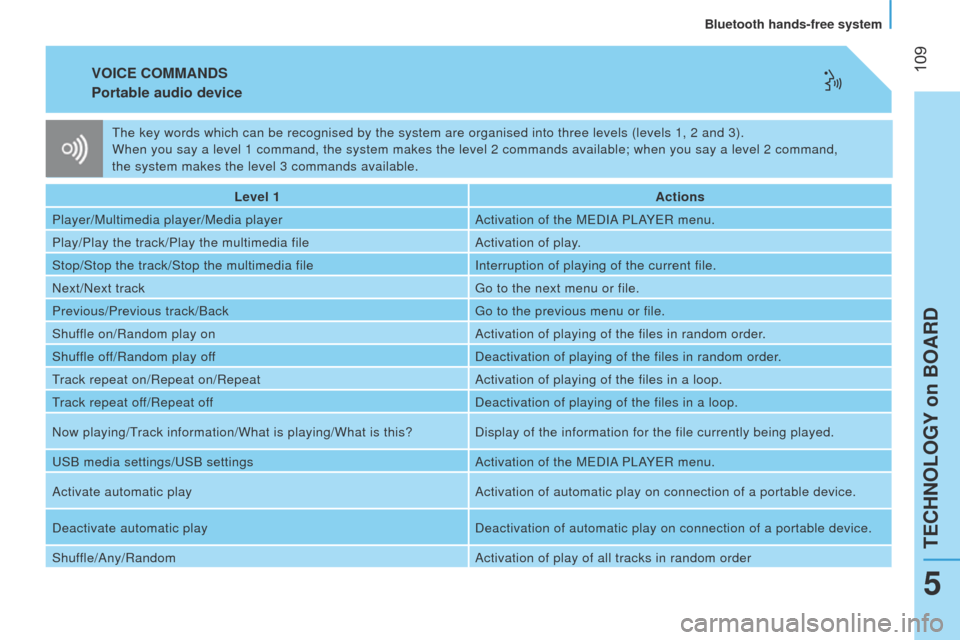
109
Bipper_en_Chap05_technologie_ed02-2014
VOICE COMMANDS
Portable audio
device
Level 1 Actions
Player/Multimedia player/Media player Activation of the M
e DIA P l AY e R menu.
Play/Play the track/Play the multimedia file Activation of play.
Stop/Stop the track/Stop the multimedia file Interruption of playing of the current file.
Next/Next track
g
o to the next menu or file.
Previous/Previous track/Back
g
o to the previous menu or file.
Shuffle on/Random play on Activation of playing of the files in random order.
Shuffle off/Random play off Deactivation of playing of the files in random order.
track repeat on/Repeat on/RepeatActivation of playing of the files in a loop.
track repeat of
f/Repeat off Deactivation of playing of the files in a loop.
Now playing/
t
rack information/What is playing/What is this? Display of the information for the file currently being played.
u
SB media settings/
u
SB settings Activation of the M
e DIA P l AY e R menu.
Activate automatic play Activation of automatic play on connection of a portable device.
Deactivate automatic play Deactivation of automatic play on connection of a portable device.
Shuffle/Any/Random Activation of play of all tracks in random order
t
he key words which can be recognised by the system are organised into th\
ree levels (levels 1, 2 and 3).
When you say a level 1 command, the system makes the level 2 commands av\
ailable; when you say a level 2 command,
the system makes the level 3 commands available.
teCHNOlOgY on BOARD
Bluetooth hands-free system
5
Page 120 of 192

11 8
Bipper_en_Chap06_securite_ed02-2014
FRONT SEAT BELTS
the front seats are fitted with pre-tensioners
and force limiters.
Fastening
Pull the strap, then insert the tongue into the
buckle.
Check that the seat belt is fastened correctly
by pulling the strap.
t
he lap belt must be positioned as low as
possible on the pelvis.
t
he chest belt must
pass over the hollow of the shoulder.
Inertia reel seat belts
these are fitted with a device which locks
automatically in the event of a collision or
emergency braking.
Safety in the event of a front impact has
been improved by the introduction of
pretensioning and force limiting seat belts.
Depending on the seriousness of the
impact, the pretensioning system instantly
tightens the seat belt against the body of the
occupant.
t
he pretensioning seat belts are active when
the ignition is on.
t
he force limiter reduces the pressure of the
seat belt against the body of the occupant in
the event of an accident.
Driver's seat belt not fastened warning
lamp
When the vehicle is started, this
warning lamp comes on if the
driver has not fastened their seat
belt.
REAR SEAT BELTS (COMBI)
the 3-seat bench is fitted with three-point
inertia reel seat belts with force limiter .
t
he centre seat has a seat belt guide and
inertia reel, integrated with the seat back.
When a seat belt is not in use, you can
store its buckle in the housing provided
in the bench seat cushion.
If the driver's seat belt is unfastened,
the S
t
ARt mode of Stop & Start will
not be invoked.
t
he engine can only be
restarted using the ignition key.
Seat belts